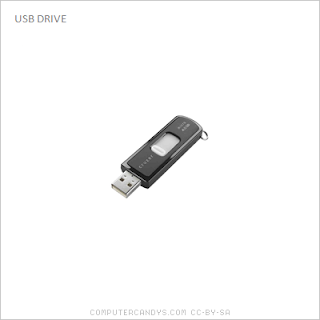WHAT IS USB DRIVE
|
|
A Flash Drive is a data storage device that includes flash memory with an integrated Universal Serial Bus (USB) interface. Flash drives are typically removable and rewritable, and physically small covered with metal or plastic which can be carried in a pocket or on a key chain.
|
|
A USB drive consists of a small printed circuit board carrying the circuit elements and a USB connector, insulated electrically and protected inside a plastic, metal, or rubberized case which can be carried in a keychain, pocket or wallet, for example. The USB connector may be protected by a removable cap or by retracting into the body of the drive, although it is not likely to be damaged if unprotected.
Most flash drives use a standard type-A USB connection allowing connection with a port on a personal computer, but drives for other interfaces also exist. USB flash drives draw power from the computer via the USB connection.
A USB drive is a small, portable device that plugs into a computer's USB port. USB flash drives are often used for the same purposes for which external HDD or SSD were used, for storage, data back-up and transfer of computer files. They are smaller, faster, have large capacity, and are durable and reliable because they have no moving parts. Additionally, they are immune to electromagnetic interference, and are unharmed by surface scratches.
Since they are small in size but have large storage capacities, flash drives have replaced most previous portable data storage mediums such as floppy disks and zip disks.
A USB drives use the USB mass storage standard, supported natively by modern operating systems such as Windows, Linux, OS X, Mac and other Unix-like systems, so you can transfer files from different types of operating system. They are supported on all public machines, although some flash drives require a user to install drivers before use. Flash drives can hold any type of data, including program, ms office, movie, music, text files or many application.
Difference between USB 1.0, USB 1.1, USB 2.0, USB 3.0:
USB 1.0 • or Low-speed, with data transfer rate of up to 1.5 Mbps.
USB 1.1 • or Full-speed, with data transfer rate of up to 12 Mbps.
USB 2.0 • or Hi-speed, with data transfer rate of 480 Mbps.
USB 3.0 • or Super-Speed, with data transfer rate of up to 5 Gbps.
USB drives capacity: 1GB 2GB 4GB 8GB 16GB 32GB 64GB 128GB 256GB 500GB up to 1TB.
NOTE: You should always make a backup copy of any important work you’ve completed. As you create large project, compile program, office document or simple assignment. Data loss can be a common experience of computer users so always keep a backup of your important files. Make a backup on your USB drive and save it separate from your computer.
USB drives is also known as: flash drive, keychain drive, thumb drive, jump drive, memory unit, data stick, pen drive or tokens.
